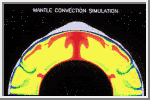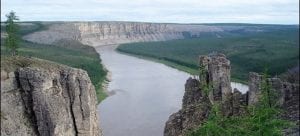The Siberian Traps
Most geologists point to the Siberian Traps as the ‘smoking gun’, the key culprit in understanding the Permo-Triassic mass extinction (PTME). These comprise the largest volcanic eruption in Earth history and they occured right at the time of the extinction.
The eruptions
 The Siberian Traps are an example of a large igneous province (LIP), basalt-like lavas that erupted over a mantle plume. A mantle plume (right) is a giant pulse of heat that rises towards the surface from the core/mantle boundary. Plumes are easily indentified but not well understood and they are believed to be part of a cooling mechanism for the core. Whatever their cause, a large amount of anomalously hot material rises to the surface and ponds below the Earth’s crust in a head that can be 1000s of km wide and 100s of km deep.
The Siberian Traps are an example of a large igneous province (LIP), basalt-like lavas that erupted over a mantle plume. A mantle plume (right) is a giant pulse of heat that rises towards the surface from the core/mantle boundary. Plumes are easily indentified but not well understood and they are believed to be part of a cooling mechanism for the core. Whatever their cause, a large amount of anomalously hot material rises to the surface and ponds below the Earth’s crust in a head that can be 1000s of km wide and 100s of km deep.
This pond of basalt magma penetrates the crust through fissures pouring gigantic amounts of basalt onto the surface. Events like this are known as flood basalt eruptions, and they are very rare, with only eight known to have occurred in the last 250 million years.
 The Siberian Traps form great thicknesses of layered lavas (left), and they are centred around the city of Tura, and they also encompass Yakutsk, Noril’sk and Irkutsk. Present coverage including associated pyroclastics is just under 2 million square kilometres which is an area greater than that of Europe. Estimates of the original volume of the traps range from 1 million cubic km up to 4 million cubic km. According to Wignall (1999), “the distribution of lavas suggests that they do not constitute a single continuous province but rather the amalgamation of several subprovinces.”
The Siberian Traps form great thicknesses of layered lavas (left), and they are centred around the city of Tura, and they also encompass Yakutsk, Noril’sk and Irkutsk. Present coverage including associated pyroclastics is just under 2 million square kilometres which is an area greater than that of Europe. Estimates of the original volume of the traps range from 1 million cubic km up to 4 million cubic km. According to Wignall (1999), “the distribution of lavas suggests that they do not constitute a single continuous province but rather the amalgamation of several subprovinces.”
The eruptions lasted over 1-2 million years, with sudden pulses of eruption, and then quiet periods. The age span coincides with the extinction, but the eruptions probably started before the peak of extinction, and may have continued for up to 1 Myr after the PTME.
The largest eruption in historic memory was the Laki eruption in Iceland in 1783-84, which spewed out 12 cubic km of lava. The poisonous gases are recorded as killing most of the island’s crops and foliage, as well as flocks of sheep, and lowering global temperatures by about 1 degree. If events this size can affect temperatures and large areas then the effects of a large scale flood basalt are incomprehensible.
Read more about the Siberian Traps here.
How could the Siberian Traps cause global mass destruction?
The immediate area would have been affected by lava and pyrocastic flows, but how does this affect the other side of the world? The real power of the Siberian Traps was the climate altering potential by the emission of ash and gases. The gas emissions in particular had two main effects that, even though they are opposite to each other, act on differing timescales.
Initially, sulphur aerosols and volcanic ash enveloped the Earth’s atmosphere, blocking out sunlight and sending surface temperatures plunging. Ash and sulphur aerosols can remain in the upper atmosphere for 100s to 1000s of years, which would have been enough to cause a significant glaciation.
The second major effect was the emission of greenhouse gases such as CO2, methane and water vapour, leading to global warming. Greenhouse gases warm the atmosphere by allowing sunlight to pass through, and heat reflected by the Earth cannot penetrate the atmosphere so is retained. Greenhouse gases stay in the atmosphere much longer, so their climate changing effects can last for millions of years.

Model of likely environmental consequences of the Siberian Traps eruptions, showing the flows of consequences of global warming and acid rain. Causal links are indicated by solid arrows, and possible second-order controls on the negative carbonate C-isotope excursion at the EPME are indicated by dashed lines. Modified from Algeo et al. (2011), and based on an earlier version by Wignall (2001).
Another effect is the destruction of the ozone layer caused by gas emissions. Chlorine and fluorine gases are emitted during almost all volcanic eruptions and these destroy the ozone layer. Without the ozone layer, harmful UV rays can kill organisms, so contributing to a mass extinction.
Global warming, estimated to have pushed global temperatures up by 5-10o C (Sun et al. 2012), was only one effect following the Siberian Traps eruptions. In addition, the volcanic gases (sulphur dioxide, carbon dioxide, fluorine, chlorine), when mixed with water in the atmosphere, produce acid rain. There is evidence for worldwide devastation of forests at this point. Trees were killed and forests disappeared. Without their binding roots, soils were removed and washed into the oceans. Evidence for this was a major switch in sedimentation style, from low-energy meandering rivers to high-energy braided streams that deposited breccias in many sections. This was first noted in Russia (Newell et al., 1999; read more here), then in South Africa (Ward et al., 2000), and elsewhere. Backing evidence is a spike in silica wash-off into the ocean at the same time (Algeo and Twitchett 2010).
Global warming also caused ocean acidification because of elevated levels of atmospheric CO2, and anoxia because of alterations to normal patterns of circulation. There is widespread evidence for anoxia in the organic-rich, black shales and dark grey limestones in many marine sections just above the extinction levels, as well as pyrite in many places (a classic indicator of anoxia).
Other explanations for the PTME
Classically, geologists pointed to a broad range of explanations for the PTME. This was partly because the extinction was so profound (which might imply a vast array of serious extinction drivers) and partly because dating of the event was unclear: did the extinctions last over 5-10 Myr, and indeed were there numerous peaks of extinction? At least, the mass extinction and the Siberian Traps eruptions are now dated rather precisely, and the focus has centred on the Siberian Traps.
Other, older, explanations for the PTME, are summarised here:
- Impact: Evidence for impact at the Permo-Triassic boundary was presented by Becker et al. (2004) – a possible crater in Australia, and other indicators, but these have been disputed.
- Climate change was also noted in earlier years, with evidence for cooling and glaciation sometimes mentioned, and more often the suggestion was made that climates became steadily warmer. The warming trend through the Permian is widely accepted (Joachimski et al. 2012), but it is not clear how this on its own could have caused the profound PTME.
- Supercontinent fusion was one of the first suggestions. As Gondwana and Laurasia moved closer and drove together in the Early Permian, the supercontinent Pangea was formed. This had many consequences, such as the loss of inland seas, increase of the inland, continental, desertified area, and associated reduction in endemicity, as regional faunas and floras on land and in shallow seas mixed together.
- Glaciation had been suggested, perhaps caused by a move of the northern and southern portions of Pangaea over the poles, and consequent build-up of ice sheets. This idea is though much debated, and evidence is limited.
References
- Algeo, T.J., Chen, Z.Q., Fraiser, M.L., Twitchett, R.J. 2011. Terrestrial-marine teleconnections in the collapse and rebuilding of Early Triassic marine ecosystems. Palaeogeography, Palaeoclimatology, Palaeoecology 308, 1-11.
- Algeo, T.J. and Twitchett, R.J. 2010. Anomalous Early Triassic sediment fluxes due to elevated weathering rates and their biological consequences. Geology 38, 1023-1026.
- Becker, L., Poreda, R. J., Basu, A. R., Pope, K. O., Harrison, T. M., Nicholson, C., & Iasky, R. 2004. Bedout: A possible end-Permian impact crater offshore of northwestern Australia. Science 304, 1469-1476.
- Joachimski, M.M., Lai, X., Shen, S., Jiang, H., Luo, G., Chen, B., Chen, J., and Sun, Y. 2012. Climate warming in the latest Permian and the Permian-Triassic mass extinction. Geology 40, 195-198.
- Newell, A.J., Tverdokhlebov, V.P., Benton, M.J. 1999. Interplay of tectonics and climate on a transverse fluvial system, Upper Permian, Southern Uralian Foreland Basin, Russia. Sedimentary Geology 127, 11-29.
- Sun, Y., Joachimski, M.M., Wignall, P.B., Yan, C., Chen, Y., Jiang, H., Wang, L., Lai, X. 2012. Lethally hot temperatures during the Early Triassic greenhouse. Science 338, 366-370.
- Ward, P.D., Montgomery, D.R., Smith, R. 2000. Altered river morphology in South Africa related to the Permian-Triassic extinction. Science 289, 1740-1743.
- Wignall, P.B., 2001. Large igneous provinces and mass extinctions. Earth-Science Reviews 53, 1-33.

